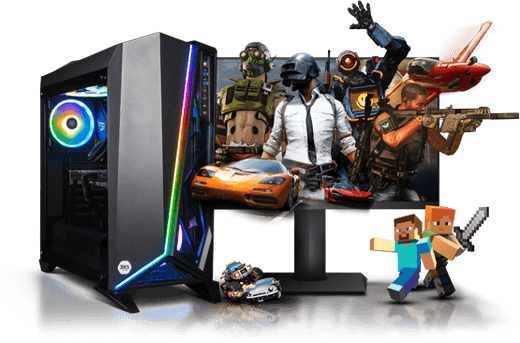What is the difference between a high-performance gaming computer designed especially for professional gamers and a standard desktop computer? Here are some recommended hardware specifications for the optimal configuration of a gaming computer. His heart rate accelerates, his fingers are ready for action, his senses are alert, and now he concentrates on the mission. These are just a few thoughts that go through the head of a gamer.

So what’s the best setup your gaming computer should have? If you are assembling a computer in parts, for games, or if you purchased pre-assembled equipment, you should consider some of the following features:
The Brain of the Gaming Computer
Make sure your gaming computer works like a human being: you need a brain to think and a body or parts for everything to work together.
Processor
Speed is the most important thing when choosing a processor for your PC. No one likes a slow system for games when a mouse click is clicked, and 20 seconds later, it displays the result on the screen. 20 seconds can mean the difference between being alive or dead in an action game (first person). Another problem is the freezing of the screen or when the game seems to be running in slow motion.
To avoid these complications, it is right to choose powerful and fast processors, with at least four cores, capable of simultaneously running various processes. In terms of processors, two brands dominate the market: Intel and AMD. It is useless to discuss which is better because they work differently, and each has advantages and disadvantages. Intel’s most advanced processors are core i5 and Core i7. Concerning AMD, the best gaming processors belong to the FX series.
Ram
RAM is another key point because most PC games require at least 4GB of RAM to work. However, with 4 GB of RAM, the computer’s performance will not be optimal, so it is recommended to have 8 GB or 12 GB of RAM. The higher the RAM, the better the gaming experience.
Graphics card or video card
Speed is a significant point, but what about quality? Sharp and radiant graphics, image quality, game design, and characters, everything should be as realistic as possible. The lush, vivid, detail-rich landscapes and various kinds of characters such as orcs or night elves, these features deserve a quality image. This type of game, by default, requires a high-end video card to deliver quality performance. High resolution and in-memory capacity for integrated graphics are two key factors in choosing a graphics card for your gaming equipment.
The Computer Corps for Gaming
Storage devices
A golden rule when it comes to hard drive space is that no matter how much you have, it’s never enough. This harsh reality is especially true for video games that require a lot of hard drive space to store installation and configuration files. For example, Battlefield 3 requires at least 20 GB of installation space, and this is a relatively small amount, considering that running the game requires a similar amount on the disk. The capacity of a gaming PC can be composed of primary and secondary storage. Today’s primary storage uses solid-state drives (SSDs) that store the operating system and upload file system at an accelerated rate. Secondary storage is intended for storing game data and files. Its capacity must be at least 500 GB.
More convenient storage should use at least 1 TB, especially if you save many other files, such as movies and images. Optical drives, DVDs are necessary because, without them, it is impossible to install some games; although already less than 60% of the games come on DVD because many can be downloaded from the Internet, and some games movies are now available on Blue-Ray. USB ports are also required to connect external hard drives or peripherals for USB games such as rudders, joysticks, or gamepads.
Screen or Monitor for a gaming computer
The monitor is one of the most important gaming peripherals. Ultimately, the game experience depends on the quality of the images. But what makes the quality of a gaming monitor good? For starters, a fast response rate. To avoid delay or the “ghost effect,” when an image remains on the screen for some time, the next image appears crossed with the previous one, the phantom effect occurs. This depends significantly on the quality of the monitor, especially with games that require high-quality graphics.
In this case, it is indicated to look for a response rate value of less than 8 ms, which minimizes the phantom effect. It is also important to consider the video’s quality concerning angle, resolution, and color. Screen size also plays a key role. Avoid visual fatigue by using a tiny screen. Therefore, a screen of 20 to 24 inches is the most suitable size for a gaming PC.
Other computer accessories
Mouse and keyboard are optional add-ons for games, but they still help improve your computer’s performance. With programmable function buttons, as well as the backlight on keys and LED light controls. Many computer mice and keyboards are designed exclusively for games, which will give you a definite advantage for any game. Many of them have an ergonomic design that allows you to spend several hours playing and reduce hand pains.
